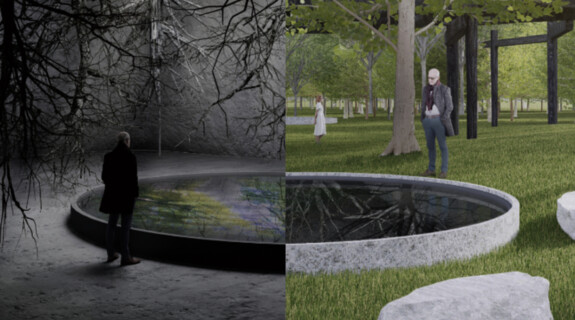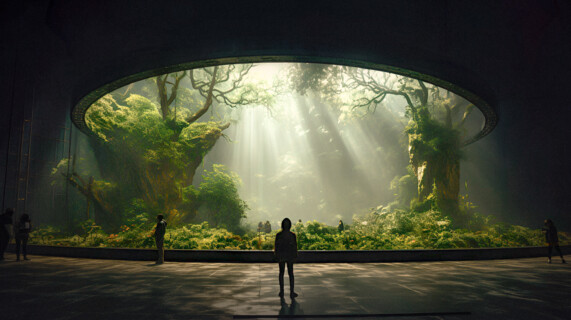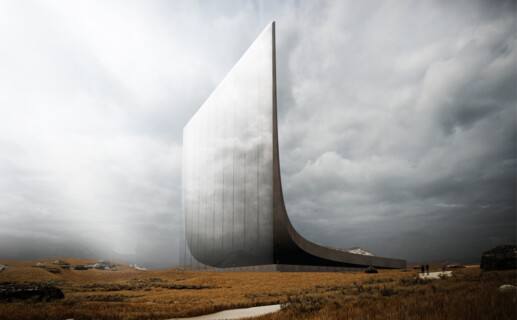- wa-ID
- wa-2035505
- Tag der Veröffentlichung
- 19.01.2023
- Aktualisiert am
- 16.11.2023
- Verfahrensart
- Offener Wettbewerb
- Zulassungsbereich
-
Andere
- Teilnehmer
- Keine Teilnahmebeschränkungen
- Auslober
- Buildner Architecture Competitions
- Bewerbungsschluss
- 21.07.2023
- Abgabetermin
- 31.08.2023
- Bekanntgabe
- 09.10.2023
Verfahrensart
Offener Ideenwettbewerb
Wettbewerbsaufgabe
Wenn man ein Gebäude betritt, denkt man vielleicht nicht sofort daran, wie man sich darin fühlt, aber Architektur hat schon immer einen großen Einfluss auf die Emotionen gehabt. Verschiedene Räume sind so gestaltet, dass sie bei ihren Bewohnern unterschiedliche Gefühle auslösen. In Büros kann man sich angeregt und produktiv fühlen, in Kunstgalerien nachdenklich und neugierig und in Museen ruhig und fasziniert. Jeder dieser Räume unterscheidet sich völlig von den anderen und ist weit mehr als nur ein Gebäude.
Im Rahmen einer Reihe von jährlich stattfindenden Architekturwettbewerben stellt der Wettbewerb Museum of Emotions die Teilnehmer vor die Aufgabe, die Architektur als Instrument zu nutzen, um verschiedene Emotionen hervorzurufen. Sie sollen ein Museum entwerfen, das zwei getrennte Ausstellungsräume umfasst, die unterschiedliche Emotionen hervorrufen - einen, der negative Emotionen hervorruft, und einen, der positive Emotionen hervorruft.
Die Teilnehmer können die Emotionen, die sie mit ihren Entwürfen hervorrufen, frei wählen - Angst, Wut, Sorge, Liebe, Glück, Lachen usw. Ziel des Museums der Gefühle ist es, die Architektur als primäres Instrument zur Erzeugung emotionaler Zustände zu nutzen, indem die Größe der Räume, der Weg durch den Raum, Farbe, Beleuchtung und Materialwahl berücksichtigt werden.
Da es sich um einen Ideenwettbewerb handelt, sind die Teilnehmer frei in der Wahl des Ortes, ob real oder imaginär, sowie in der Größe ihrer Struktur.
Museum of Emotions / Edition #3 ist einer von Buildners' stillen Wettbewerben, bei denen die Teilnehmer ihre Ideen ohne die Verwendung von Text kommunizieren müssen. Das Entwurfskonzept und die Überlegungen, die dahinter stehen, müssen allein durch die Verwendung von Bildmaterial vermittelt werden.
Competition assignment
It may not be your first instinct when entering a building to consider how it makes you feel, but architecture has always had a big impact on emotions. Different spaces are designed to make their inhabitants feel different things; offices can make you feel energised and productive, art galleries can make you feel thoughtful and curious, and museums can make you feel calm and intrigued. Each of these spaces is completely different from each other and is far more than just a building.
As part of a series of annual architecture competitions, the Museum of Emotions competition is tasking participants with using architecture as a tool to bring out different emotions. They are asked to design a museum that includes two separate exhibition halls that bring out contrasting emotions – one inducing negative emotions, and the other inducing positive emotions.
Participants are free to choose the specific emotions they incite with their designs – fear, anger, anxiety, love, happiness, laughter, etc. The purpose of the Museum of Emotions is to use architecture as the primary tool to create emotional states, through consideration of the scales of the spaces, the journey through the space, colour, lighting, and material choice.
As this is an ideas competition, participants are free to choose any site location, real or imaginary, as well as the size of their structure.
Museum of Emotions / Edition #3 is one of Buildners‘ silent competitions, in which participants must communicate their ideas without the use of any text. The design concept and thinking behind it must all be communicated solely through the use of visuals.
Jury
Ben van Berkel, Founder and Principle of Amsterdam-based UNStudio;
Stephanie Deumer, Canadian Visual Artist currently living and working in Los Angeles;
Lydia Kallipoliti, architect, engineer, scholar and an Assistant Professor at the Cooper Union in New York and the principal of ANAcycle thinktank;
Nina Freedman, Principal of DREAMLAND CREATIVE PROJECTS (DCP);
James Krueger, Design Principal in HMC Architects’ San Diego studio;
Françoise N’Thépé, runs Paris-based practice FRANÇOISE N’THÉPÉ ARCHITECTURE & DESIGN;
Nuno Pimenta, runs a transdisciplinary practice in Porto, with a portfolio that spans temporary architecture, installation, public art, exhibition design and performance;
Angelo Renna, Italy-based architect;
Yu-Ying Tsai, lead architect at Shanghai-based ZJJZ Atelier
Weitere Informationen zu den Gewinner*innen finden Sie unter /
More information about the winners can be found at:
architecturecompetitions.com/museumofemotions3
Offener Ideenwettbewerb
Wettbewerbsaufgabe
Wenn man ein Gebäude betritt, denkt man vielleicht nicht sofort daran, wie man sich darin fühlt, aber Architektur hat schon immer einen großen Einfluss auf die Emotionen gehabt. Verschiedene Räume sind so gestaltet, dass sie bei ihren Bewohnern unterschiedliche Gefühle auslösen. In Büros kann man sich angeregt und produktiv fühlen, in Kunstgalerien nachdenklich und neugierig und in Museen ruhig und fasziniert. Jeder dieser Räume unterscheidet sich völlig von den anderen und ist weit mehr als nur ein Gebäude.
Im Rahmen einer Reihe von jährlich stattfindenden Architekturwettbewerben stellt der Wettbewerb Museum of Emotions die Teilnehmer vor die Aufgabe, die Architektur als Instrument zu nutzen, um verschiedene Emotionen hervorzurufen. Sie sollen ein Museum entwerfen, das zwei getrennte Ausstellungsräume umfasst, die unterschiedliche Emotionen hervorrufen - einen, der negative Emotionen hervorruft, und einen, der positive Emotionen hervorruft.
Die Teilnehmer können die Emotionen, die sie mit ihren Entwürfen hervorrufen, frei wählen - Angst, Wut, Sorge, Liebe, Glück, Lachen usw. Ziel des Museums der Gefühle ist es, die Architektur als primäres Instrument zur Erzeugung emotionaler Zustände zu nutzen, indem die Größe der Räume, der Weg durch den Raum, Farbe, Beleuchtung und Materialwahl berücksichtigt werden.
Da es sich um einen Ideenwettbewerb handelt, sind die Teilnehmer frei in der Wahl des Ortes, ob real oder imaginär, sowie in der Größe ihrer Struktur.
Museum of Emotions / Edition #3 ist einer von Buildners' stillen Wettbewerben, bei denen die Teilnehmer ihre Ideen ohne die Verwendung von Text kommunizieren müssen. Das Entwurfskonzept und die Überlegungen, die dahinter stehen, müssen allein durch die Verwendung von Bildmaterial vermittelt werden.
Competition assignment
It may not be your first instinct when entering a building to consider how it makes you feel, but architecture has always had a big impact on emotions. Different spaces are designed to make their inhabitants feel different things; offices can make you feel energised and productive, art galleries can make you feel thoughtful and curious, and museums can make you feel calm and intrigued. Each of these spaces is completely different from each other and is far more than just a building.
As part of a series of annual architecture competitions, the Museum of Emotions competition is tasking participants with using architecture as a tool to bring out different emotions. They are asked to design a museum that includes two separate exhibition halls that bring out contrasting emotions – one inducing negative emotions, and the other inducing positive emotions.
Participants are free to choose the specific emotions they incite with their designs – fear, anger, anxiety, love, happiness, laughter, etc. The purpose of the Museum of Emotions is to use architecture as the primary tool to create emotional states, through consideration of the scales of the spaces, the journey through the space, colour, lighting, and material choice.
As this is an ideas competition, participants are free to choose any site location, real or imaginary, as well as the size of their structure.
Museum of Emotions / Edition #3 is one of Buildners‘ silent competitions, in which participants must communicate their ideas without the use of any text. The design concept and thinking behind it must all be communicated solely through the use of visuals.
Jury
Ben van Berkel, Founder and Principle of Amsterdam-based UNStudio;
Stephanie Deumer, Canadian Visual Artist currently living and working in Los Angeles;
Lydia Kallipoliti, architect, engineer, scholar and an Assistant Professor at the Cooper Union in New York and the principal of ANAcycle thinktank;
Nina Freedman, Principal of DREAMLAND CREATIVE PROJECTS (DCP);
James Krueger, Design Principal in HMC Architects’ San Diego studio;
Françoise N’Thépé, runs Paris-based practice FRANÇOISE N’THÉPÉ ARCHITECTURE & DESIGN;
Nuno Pimenta, runs a transdisciplinary practice in Porto, with a portfolio that spans temporary architecture, installation, public art, exhibition design and performance;
Angelo Renna, Italy-based architect;
Yu-Ying Tsai, lead architect at Shanghai-based ZJJZ Atelier
Weitere Informationen zu den Gewinner*innen finden Sie unter /
More information about the winners can be found at:
architecturecompetitions.com/museumofemotions3
Museum of Emotions / Edition #3
Organizers
Buildner Architecture Competitions
About the Competition
It may not be your first instinct when entering a building to consider how it makes you feel, but architecture has always had a big impact on emotions. Different spaces are designed to make their inhabitants feel different things; offices can make you feel energised and productive, art galleries can make you feel thoughtful and curious, and museums can make you feel calm and intrigued. Each of these spaces is completely different from each other and is far more than just a building.
As part of a series of annual architecture competitions, the Museum of Emotions competition is tasking participants with using architecture as a tool to bring out different emotions. They are asked to design a museum that includes two separate exhibition halls that bring out contrasting emotions – one inducing negative emotions, and the other inducing positive emotions.
Participants are free to choose the specific emotions they incite with their designs – fear, anger, anxiety, love, happiness, laughter, etc. The purpose of the Museum of Emotions is to use architecture as the primary tool to create emotional states, through consideration of the scales of the spaces, the journey through the space, colour, lighting, and material choice.
As this is an ideas competition, participants are free to choose any site location, real or imaginary, as well as the size of their structure.
Museum of Emotions / Edition #3 is one of Buildners‘ silent competitions, in which participants must communicate their ideas without the use of any text. The design concept and thinking behind it must all be communicated solely through the use of visuals.
Eligibility
Competition is open to all. No professional qualification is required.
Design proposals can be developed individually or by teams (4 team members maximum).
Correspondence with organizers must be conducted in English;
All information submitted by participants must be in English.
Schedule
Closing date for registration: 21 July 2023
Closing date for project submission: 31 August 2023 (11:59pm London time)
Announcement of winners: 09 October 2023
Prizes
Total Prize Fund: 7,000 €
1st Prize: 3,000 € + Publications + Certificate of Achievement
2nd Prize: 1,500 € + Publications + Certificate of Achievement
3rd Prize: 1,000 € + Publications + Certificate of Achievement
BUILDNER STUDENT AWARD: 1,000 € + 50 € ARCHHIVE BOOKS Gift Card + 50 Points BUILDNER Architecture University Rankings + Publications + Certificate of Achievement
BUILDNER SUSTAINABILITY AWARD: 500 € + Publications + Certificate of Achievement
6 Honorable Mentions: Publications + Certificate of Achievement
More information and documents at


















